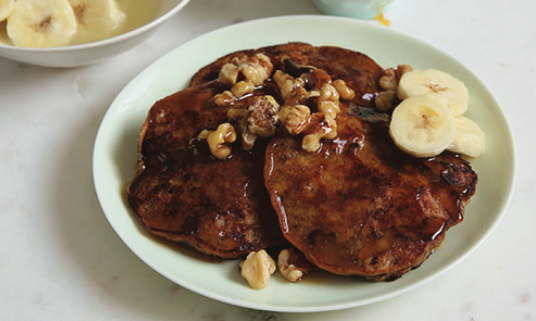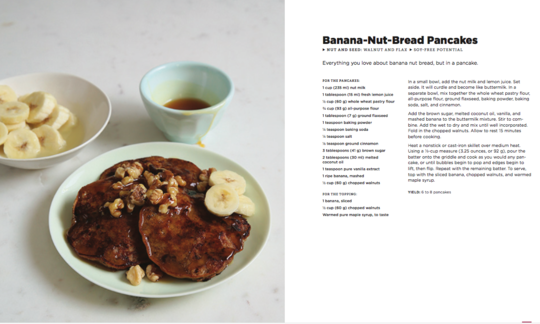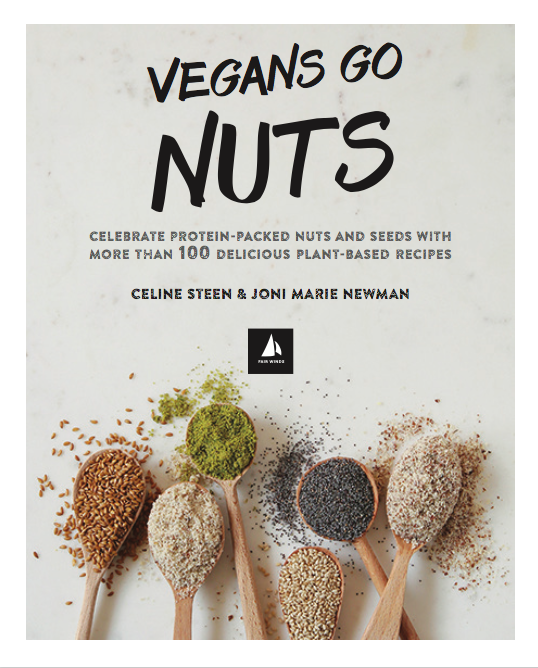Banana-Nut-Bread Pancakes with Flaxseed and Walnuts
vegan
Ingredients (for servings, )
| For the pancakes | |
|---|---|
| 235 ml | Almond milk (raw?, organic?) (7.9 oz) |
| 15 ml | Lemon juice (raw?, organic?) (0.54 oz) |
| 1 tbsp, ground | Linseed, raw, organic? (golden linseed, flax) (0.25 oz) |
| 2 ⅛ oz | Wheat flour, wholemeal (organic?) |
| 3 ⅓ oz | Wheat flour (raw?, organic?) |
| 1 tsp | Baking powder (baking agent, organic?, vegan?) (0.11 oz) |
| ¼ tsp | Baking soda (organic?) (0.04 oz) |
| ¼ tsp | Table salt (table salt, raw?, organic?) (0.05 oz) |
| ½ tsp | Cinnamon (ground, raw, organic?) (0.05 oz) |
| 1 | Bananas, raw (organic?) (4.1 oz) |
| 3 tbsp | Brown sugar (raw sugar, whole cane sugar, whole sugar, organic?) (0.95 oz) |
| 2 tbsp | Coconut oil (coconut oil, coconut fat, organic?, raw?) (0.96 oz) |
| 1 tsp | Vanilla extract, natural (organic?) (0.15 oz) |
| 2 ⅛ oz | Walnuts (tree nuts), raw (organic?) |
| For the topping | |
| 1 | Bananas, raw (organic?) (4.1 oz) |
| 2 ⅛ oz | Walnuts (tree nuts), raw (organic?) |
| 1 tbsp | Maple syrup (organic?, raw?) (0.70 oz) |
Equipment
- whisk
- skillet (frying pan)
- stove
- coffee grinder, electric
- citrus juicer (lemon squeezer)
Type of preparation
- fry
- chop or grind
- blend
- squeeze
- meld
- melt
Preparation
For the pancakes
In a small bowl, add the nut milk and lemon juice. Set aside. It will curdle and become like buttermilk.The original recipe calls for nut milk. We have listed almond milk as it is readily available. For further information on nut milk and making your own, please see the “Tips” section.
Grind the flaxseed (e.g., in an electric coffee grinder). In a separate bowl, mix together the whole wheat flour, flour, ground flaxseed, baking powder, baking soda, salt, and cinnamon.
Mash the ripe banana with a fork. Add the brown sugar, melted coconut oil, vanilla, and mashed banana to the buttermilk mixture. Stir to combine. Add the wet to dry and mix until well incorporated. Chop the walnuts and fold in to the mixture. Allow to rest 15 minutes before cooking.
The authors use ripe bananas for the batter and the topping.
Heat a nonstick or cast-iron skillet over medium heat. Using a 1⁄3-cup measure (3.25 ounces or 92 g), pour the batter onto the griddle and cook as you would any pancake, or until bubbles begin to pop and edges begin to lift, then flip. Repeat with the remaining batter.
The ingredients for 4 servings yield enough for 6–8 pancakes (depending on the thickness).
Serve
Slice the bananas. Chop the walnuts and warm the maple syrup. To serve, top with the sliced banana, chopped walnuts, and warmed maple syrup (to taste).
|
Nutritional Information per person
Convert per 100g
|
2000 kcal | |
|---|---|---|
| Energy | 507 kcal | 25.4% |
| Fat/Lipids | 29 g | 41.3% |
| Saturated Fats | 7.8 g | 38.8% |
| Carbohydrates (inc.dietary fiber) | 57 g | 21.1% |
| Sugars | 18 g | 20.0% |
| Fiber | 6.7 g | 26.9% |
| Protein/Albumin | 11 g | 21.3% |
| Cooking Salt (Na:350.1 mg) | 889 mg | 37.0% |
| Essential micronutrients with the highest proportions | per person | 2000 kcal | |
|---|---|---|---|
| Fat | Alpha-Linolenic acid; ALA; 18:3 omega-3 | 3.2 g | 158.0% |
| Fat | Linoleic acid; LA; 18:2 omega-6 | 12 g | 122.0% |
| Min | Manganese, Mn | 2.2 mg | 112.0% |
| Min | Copper, Cu | 0.66 mg | 66.0% |
| Prot | Tryptophan (Trp, W) | 0.12 g | 49.0% |
| Elem | Phosphorus, P | 332 mg | 47.0% |
| Sodium, Na | 350 mg | 44.0% | |
| Min | Selenium, Se | 21 µg | 38.0% |
| Prot | Threonine (Thr, T, irreversibly transaminated) | 0.35 g | 37.0% |
| Vit | Vitamin B6 (pyridoxine) | 0.46 mg | 33.0% |
Detailed Nutritional Information per Person for this Recipe
The majority of the nutritional information comes from the USDA (US Department of Agriculture). This means that the information for natural products is often incomplete or only given within broader categories, whereas in most cases products made from these have more complete information displayed.
If we take flaxseed, for example, the important essential amino acid ALA (omega-3) is only included in an overarching category whereas for flaxseed oil ALA is listed specifically. In time, we will be able to change this, but it will require a lot of work. An “i” appears behind ingredients that have been adjusted and an explanation appears when you hover over this symbol.
For Erb Muesli, the original calculations resulted in 48 % of the daily requirement of ALA — but with the correction, we see that the muesli actually covers >100 % of the necessary recommendation for the omega-3 fatty acid ALA. Our goal is to eventually be able to compare the nutritional value of our recipes with those that are used in conventional western lifestyles.
| Essential fatty acids | per person | 2000 kcal |
|---|---|---|
| Alpha-Linolenic acid; ALA; 18:3 omega-3 | 3.2 g | 158.0% |
| Linoleic acid; LA; 18:2 omega-6 | 12 g | 122.0% |
| Essential amino acids | per person | 2000 kcal |
|---|---|---|
| Tryptophan (Trp, W) | 0.12 g | 49.0% |
| Threonine (Thr, T, irreversibly transaminated) | 0.35 g | 37.0% |
| Isoleucine (Ile, I) | 0.40 g | 33.0% |
| Phenylalanine (Phe, F) | 0.52 g | 33.0% |
| Leucine (Leu, L) | 0.77 g | 32.0% |
| Valin (Val, V) | 0.49 g | 30.0% |
| Methionine (Met, M) | 0.17 g | 18.0% |
| Lysine (Lys, K, irreversibly transaminated) | 0.29 g | 16.0% |
| Vitamins | per person | 2000 kcal |
|---|---|---|
| Vitamin B6 (pyridoxine) | 0.46 mg | 33.0% |
| Vitamin B7 (Biotin, ex vitamin H) | 16 µg | 31.0% |
| Vitamin B9, B11 (Folate, as the active form of folic acid) | 58 µg | 29.0% |
| Vitamin B1 (Thiamine) | 0.25 mg | 23.0% |
| Vitamin B2 (Riboflavin) | 0.28 mg | 20.0% |
| Vitamin E, as a-TEs | 1.5 mg | 13.0% |
| Vitamin B3 (Niacin) | 1.8 mg | 12.0% |
| Vitamin B5 (Pantothenic acid) | 0.60 mg | 10.0% |
| Vitamin C (ascorbic acid) | 7.0 mg | 9.0% |
| Vitamin A, as RAE | 19 µg | 2.0% |
| Vitamin K | 1.7 µg | 2.0% |
| Essential macroelements (macronutrients) | per person | 2000 kcal |
|---|---|---|
| Phosphorus, P | 332 mg | 47.0% |
| Sodium, Na | 350 mg | 44.0% |
| Magnesium, Mg | 103 mg | 27.0% |
| Potassium, K | 480 mg | 24.0% |
| Calcium, Ca | 147 mg | 18.0% |
| Essential trace elements (micronutrients) | per person | 2000 kcal |
|---|---|---|
| Manganese, Mn | 2.2 mg | 112.0% |
| Copper, Cu | 0.66 mg | 66.0% |
| Selenium, Se | 21 µg | 38.0% |
| Zinc, Zn | 1.8 mg | 18.0% |
| Iron, Fe | 2.0 mg | 14.0% |
| Iod, I (Jod, J) | 4.5 µg | 3.0% |
| Fluorine, F | 1.3 µg | < 0.1% |
'Vegans Go Nuts - celebrate protein packed nuts and seeds with more than 100 delicious plant-based recipes’ shows the diversity of nuts and seeds.
ConclusionIn Vegans Go Nuts, Celine Steen and Joni Marie Newman show the many ways in which nuts and seeds can be used. Unfortunately, the authors do not go into the major differences in the health values of the individual nuts. Also, despite the many nuts and seeds, additional oils are often used. However, by consciously using nuts with health benefits and making slight changes, you can prepare new and healthy vegan recipes with the help of the recipes listed.
|
Critical book reviews |
General impressionIn Vegans Go Nuts - celebrate protein packed nuts and seeds with more than 100 delicious plant-based recipes, Celine Steen and Joni Marie Newman have put together a large selection of nut and seed-based vegan recipes. The authors start by introducing a wide variety of nuts and seeds. They focus in particular on the differences in flavours and textures after processing the nuts and seeds and highlight the health benefits of the individual ingredients. However, this means that the disadvantages take a back seat. It would be desirable to compare the nuts in terms of their health value, in particular the ratio of omega-6 to omega-3 fatty acids, which should not exceed a ratio of 5:1. This would make it easier to select the appropriate nuts in the dishes - as the type of nut is often left to the reader's discretion. The authors emphasise that nuts and seeds are particularly beneficial in raw or dry roasted and unsalted form. The statement that all nuts are healthy, regardless of the type, is not entirely correct, especially in view of the very different ratios of essential fatty acids. You can find out more about this under the following link: Vegans often eat unhealthily.
The recipes are clearly presented and are labelled gluten-free, soy-free, oil-free and quick and easy. The additional tips (recipe notes) are a helpful addition. Unfortunately, only some of the recipes are illustrated. An additional indication of preparation times would be desirable with regard to planning. The use of many different nuts and seeds and the frequent use of wholegrains are successful from a health perspective. Unfortunately, despite the many nuts and seeds, added oils are still frequently used, but rarely a lot. Sweeteners of various kinds are also often present and, especially in desserts, in large quantities. It would be preferable to reduce these or switch to fruit sweeteners. Tinned food is also found in around one in ten dishes. A complete avoidance of processed products would also be preferable here. It is pleasing to see that many home-made ingredients such as nut butter, nut milk and similar are used, which are listed in the basics.
Vegans Go Nuts by Celine Steen and Joni Marie Newman is a vegan recipe book that demonstrates the versatility of nuts and seeds through its varied recipes.
By making slight changes and consciously using particularly healthy nuts, you can conjure up not only delicious but also healthy vegan dishes from many of the recipes listed. Vegans Go Nuts by Celine Steen and Joni Marie Newman is currently only available in English. You can buy it from Quarto Knows and Amazon.
About the authorsCeline Steen, who lives in California, switched to a vegan diet in 2005 for ethical reasons. She is the co-author of several cookery books and founder of the award-winning blog Have Cake, Will Travel.
Joni Marie Newman is the founder of justthefood.com and author of 10 cookery books. She is well known in the vegan community and is a frequent speaker at vegan conferences and other events.
Contents of the bookVegans Go Nuts is divided into 6 chapters:
- In the Kitchen with Nuts and Seeds
- Nuts and Seeds Basics
- Cheers to Nutritious Mornings
- Simple Nuts Make Mean Mains
- Substantial Soups, Sides, and Salads
- Ending Things on a Sweet Nut
In the kitchen with nuts and seeds: Here you will find a glossary of nuts and seeds, tips on storing them and a glossary of some more unusual ingredients.
Recipes
Nuts and Seeds Basics: The recipes range from simple roasted nuts to nut butters, nut milks, nut flours, spreads, dressings, dips and nut cheeses. Examples include the Almond-Milk Cream Cheese Spread and the Citrusy Cashew Baba Ghanoush.
Cheers to Nutritous Mornings:Here you will find sweet or savoury dishes in the form of muesli, pastries or savoury dishes, such as the Ginger or Lemon Tahini Scones, Banana Nut Bread Pancakes or the Protein-Packed Breakfast Scramble. You will need sweeteners for almost all the dishes, and tinned food is used for three of them.
Simple Nuts make Mean Mains: The dishes are based on quinoa, rice, chickpeas, noodles and tofu, among other things. Just under a third of the recipes require bread or tortillas, which are not part of the recipes. In 5 recipes, the authors use ready-made products (sauces and tinned food). Examples of the recipes listed are the Moroccan Pilaf with Pomegranate Walnuts, Pad Tahini and Walnut, Arugula and Grape Tacos.
Substantial Soups, Sides, and Salads: Dishes such as Potato Peanut Soup, Autumnal Chestnut and Carrot Bisque and Cauliflower Pecan Tabouleh can be served as a main course, side dish or starter.
Ending Things on a Sweet Nut: You will find toppings, ice cream, biscuits and small sweet treats here. Examples include the Baked Pears, Pistachio Macarons with Orange Ganache Filling and Nut Butter Magic Candy Ice Cream Topping. Almost all the recipes contain a fairly high proportion of sweeteners.
The cookbook Vegans Go Nuts - Nuts and Seeds with more than 100 delicious plant-based recipes concludes with a recipe index.
Book review by Dr med. vet. Inke Weissenborn
Banana-Nut-Bread Pancakes with Flaxseed and Walnuts are everything you love about banana nut bread, but in a pancake.
Servings: The ingredients for 4 servings yield enough for 6–8 pancakes (depending on the thickness).
Nutritional profile: According to GDA guidelines, one serving of this recipe covers more than the recommended daily requirement for omega-6 and omega-3 fatty acids. At 5:1, the ratio between linoleic acid (LA) and alpha-linolenic acid (ALA) is under the recommended maximum ratio of 5:1. It also covers almost 40 % of the daily requirement for selenium and 100 % for manganese.
Nut milk: This is a plant-based milk that is made from nuts and water (see “Tips”).
Flaxseed: Flaxseed are the seeds of the flax plant (common flax or linseed: Linum usitatissimum). They have a slightly nutty flavor and contain 40 % fat. Since this consists of about 50 % polyunsaturated omega-3 fatty acids (ALA), flaxseed oil has the highest concentration of omega-3 fatty acids of all known vegetable oils. People who eat a lot of convenience foods should increase the amount of flaxseed in their diet in order to in this respect somewhat compensate for poor dietary choices.
Walnuts: Walnuts are the nuts that contain the highest proportion of linolenic acid (ALA). In addition, they are rich in vitamin E, zinc (an important trace element for the liver and hair), and potassium (essential for the functioning of the heart and other organs).
Coconut oil: Coconut oil is solid at room temperature, but has a very low melting point and therefore turns very quickly to liquid. Given its high content of saturated fatty acids, coconut oil can more safely be heated to high temperatures (higher smoke point) and is as such suitable for frying, baking, deep-frying, and general cooking. But at 82 % saturated fatty acids, we do not recommend coconut oil, even if it is highly praised by the food industry. Read more about this in the article: A Vegan Diet Can Be Unhealthy. Nutrition Mistakes.
Baking powder vs. baking soda: Like baking powder, baking soda (also called sodium bicarbonate) is used to make baked goods rise better. However, it has a much stronger effect than baking powder and requires the presence of an acid to be effective. Baking powder is a mixture of sodium carbonate and a weak acid. Weinstein baking powder contains cream of tartar, which is a natural by-product in the wine-making process that is obtained from the crystalline deposits found inside wine barrels. It also contains cornstarch instead of flour (used as a separating agent).
Nut milk: We have listed almond milk as it is readily available. It is generally preferable to use unprocessed products. And it’s also easy to make your own almond milk. Here’s a recipe that you can use: Raw Almond Milk. Walnut milk is an even healthier type of plant-based milk. Walnuts have a good ratio of omega-6 to omega-3 fatty acids whereas almonds contain almost no omega-3 fatty acids.
Whole wheat flour: We recommend that you use 100 % whole wheat flour. Whole wheat flour is grain that has only had the awns and husks removed after harvesting. Fiber, vitamins, oils, and minerals are therefore retained in the bran and the germ. The oils have a particularly high nutritional value as they contain large amounts of essential fatty acids.
Healthy oils: Coconut oil contains mainly saturated fatty acids. The triglyceride content with unsaturated fatty acids is therefore extremely low. In terms of nutritional physiology, however, it is specifically the unsaturated, essential omega-6 (LA) and omega-3 fatty acids (ALA) that are important.
Canola oil contains high levels of essential fatty acids (esp. alpha-linolenic acid). With an LA:ALA ratio of 2:1, canola oil is an excellent choice and can help considerably to obtain an overall maximum ratio of 5:1. We recommend using healthy oils whenever possible.
Reducing the sugar: If you don’t need it to be so sweet, you can reduce the amount of sugar you add or even leave out the sugar. The banana alone may make the bread sweet enough.
Replace baking soda with baking powder: If you want to replace the baking soda, you can instead use two to three times the amount of baking powder.






